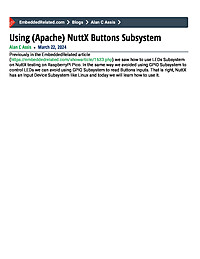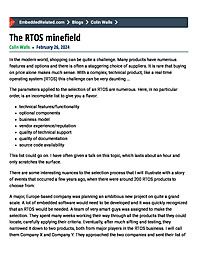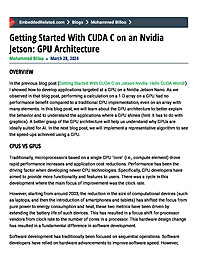
Getting Started With CUDA C on an Nvidia Jetson: GPU Architecture
In the previous blog post (Getting Started With CUDA C on Jetson Nvidia: Hello CUDA World!) I showed how to develop applications targeted at a GPU on a Nvidia Jetson Nano. As we observed in that blog post, performing a calculation on a 1-D array on a GPU had no performance benefit compared to a traditional CPU implementation, even on an array with many elements. In this blog post, we will learn about the GPU architecture to better explain the behavior and to understand the applications where a GPU shines (hint: it has to do with graphics).
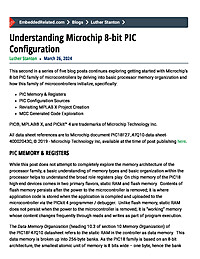
Understanding Microchip 8-bit PIC Configuration
The second post of a five part series picks up getting started developing with Microchip 8-bit PIC Microcontroller by examining the how and why of processor configuration. Topics discussed include selecting the oscillator to use during processor startup and refining the configuration once the application starts. A walk through of the code generated by the Microchip IDE provides a concrete example of the specific Configuration Word and SFR values needed to configure the project specific clock configuration.
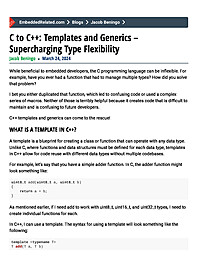
C to C++: Templates and Generics – Supercharging Type Flexibility
"C to C++: Templates and Generics – Supercharging Type Flexibility" illuminates the rigidity of C when managing multiple types and the confusion of code replication or macro complexity. In contrast, C++ offers templates, acting as type-agnostic blueprints for classes and functions, which allows for the creation of versatile and reusable code without redundancy. By using templates, developers can define operations like add once and apply them to any data type, simplifying codebases significantly. Generics further this concept, enabling a single code structure to handle diverse data types efficiently—a boon for embedded systems where operations must be performed on varying data, yet code efficiency is critical due to resource limitations. The blog walks through practical applications, showcasing how templates streamline processes and ensure type safety with static_assert, all while weighing the pros and cons of their use in embedded software, advocating for careful practice to harness their full potential.
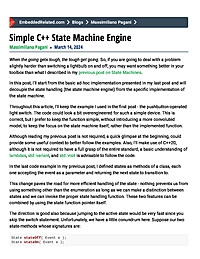
Simple C++ State Machine Engine
When implementing state machines in your project it is an advantage to rely on a tried and tested state machine engine. This component is reused for every kind of application and helps the developer focus on the domain part of the software. In this article, the design process that turns a custom C++ code into a finite-state machine engine is fully described with motivations and tradeoffs for each iteration.
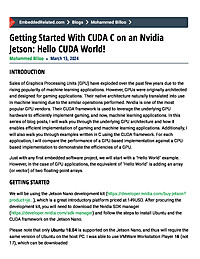
Getting Started With CUDA C on an Nvidia Jetson: Hello CUDA World!
In this blog post, I introduce CUDA, which is a framework designed to allow developers to take advantage of Nvidia's GPU hardware acceleration to efficiently implement certain type of applications. I demonstrate an implementation to perform vector addition using CUDA C and compare it against the traditional implementation in "regular" C.
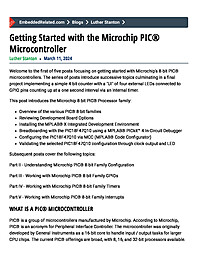
Getting Started with the Microchip PIC® Microcontroller
This first post of a five part series looks at the available hardware options for getting started with Microchip 8-bit PIC® Microcontroller, explores the MPLAB® X Integrated Development Environment and walks through setting up a project to expose the configured clock to an external pin and implement a single output GPIO to light an LED.
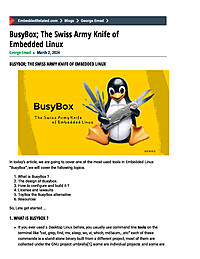
BusyBox; The Swiss Army Knife of Embedded Linux
In this article we cover the BusyBox, how it's designed to be optimized for embedded targets, and how to configure and build it in different ways, we also covered the license and limitation, which led to the development of ToyBox, I hope you enjoyed the article, please leave a comment for any correction or suggestions.
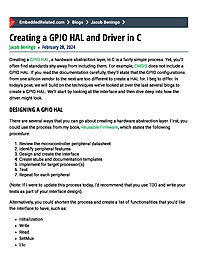
Creating a GPIO HAL and Driver in C
Creating a GPIO Hardware Abstraction Layer (HAL) in C allows for flexible microcontroller interfacing, overcoming the challenge of variability across silicon vendors. This method involves reviewing datasheets, identifying features, designing interfaces, and iterative development, as detailed in the "Reusable Firmware" process. A simplified approach prioritizes essential functions like initialization and read/write operations, showcased through a minimal interface example. The post also highlights the use of AI to expedite HAL generation. A detailed GPIO HAL version is provided, featuring extended capabilities and facilitating driver connection through direct assignments or wrappers. The significance of a configuration table for adaptable peripheral setup is emphasized. Ultimately, the blog illustrates the ease and scalability of developing a GPIO HAL and driver in C, promoting hardware-independent and extensible code for various interfaces, such as SPI, I2C, PWM, and timers, underscoring the abstraction benefits.
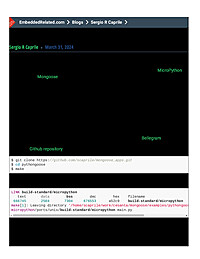
When a Mongoose met a MicroPython
This is more a framework than an actual application, with it you can integrate MicroPython and Cesanta's Mongoose.
Mongoose runs when called by MicroPython and is able to run Python functions as callbacks for the events you decide in your event handler. The code is completely written in C, except for the example Python callback functions, of course. To try it, you can just build this example on a Linux machine, and, with just a small tweak, you can also run it on any ESP32 board.

Turn It On Again: Modeling Power MOSFET Turn-On Dependence on Source Inductance
This is a short article explaining how to analyze part of the behavior of a power MOSFET during turn-on, and how it is influenced by the parasitic inductance at the source terminal. The brief qualitative reason that source inductance is undesirable is that it uses up voltage when current starts increasing during turn-on (remember, V = L dI/dt), voltage that would otherwise be available to turn the transistor on faster. But I want to show a quantitative approximation to understand the impact of additional source inductance, and I want to compare it to the effects of extra inductance at the gate or drain.

Simple C++ State Machine Engine
When implementing state machines in your project it is an advantage to rely on a tried and tested state machine engine. This component is reused for every kind of application and helps the developer focus on the domain part of the software. In this article, the design process that turns a custom C++ code into a finite-state machine engine is fully described with motivations and tradeoffs for each iteration.

Creating a GPIO HAL and Driver in C
Creating a GPIO Hardware Abstraction Layer (HAL) in C allows for flexible microcontroller interfacing, overcoming the challenge of variability across silicon vendors. This method involves reviewing datasheets, identifying features, designing interfaces, and iterative development, as detailed in the "Reusable Firmware" process. A simplified approach prioritizes essential functions like initialization and read/write operations, showcased through a minimal interface example. The post also highlights the use of AI to expedite HAL generation. A detailed GPIO HAL version is provided, featuring extended capabilities and facilitating driver connection through direct assignments or wrappers. The significance of a configuration table for adaptable peripheral setup is emphasized. Ultimately, the blog illustrates the ease and scalability of developing a GPIO HAL and driver in C, promoting hardware-independent and extensible code for various interfaces, such as SPI, I2C, PWM, and timers, underscoring the abstraction benefits.
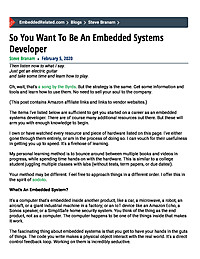
So You Want To Be An Embedded Systems Developer
Then listen now to what I say. Just get an electric guitar and take some time and learn how to play. Oh, wait, that's a song by the Byrds. But the strategy is the same. Get some information and tools and learn how to use them. No need to...
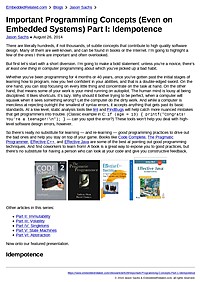
Important Programming Concepts (Even on Embedded Systems) Part I: Idempotence
There are literally hundreds, if not thousands, of subtle concepts that contribute to high quality software design. Many of them are well-known, and can be found in books or the Internet. I’m going to highlight a few of the ones I think...
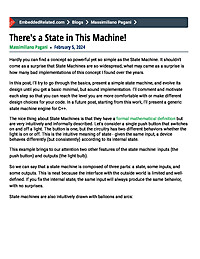
There's a State in This Machine!
An introduction to state machines and their implementation. Working from an intuitive definition of the state machine concept, we will start with a straightforward implementation then we evolve it into a more robust and engineered solution.

Soft Skills For Embedded Systems Software Developers
Contents: Introduction The Skills Interpersonal Tips For Interpersonal Skills Communications Tips For Speaking Tips For Writing Tips For Diagramming Time Management Tips For Time Management Deep Focus Tips For Deep...
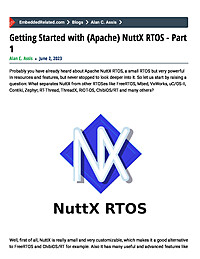
Getting Started with (Apache) NuttX RTOS - Part 1
NuttX RTOS is used in many products from companies like Sony, Xiaomi, Samsung, Google/Fitbit, WildernessLabs and many other companis. So, probably you are already using NuttX even without knowing it, like the you was using Linux on your TV, WiFi router more than 10 years ago and didn't know too! Today you will have the chance to discover a little bit of this fantastic Linux-like RTOS! Are you ready? So, let's get started!
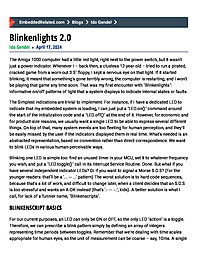
Blinkenlights 2.0
Nothing spells old movie computers like a panel of randomly blinking lights, but in fact, these so-called "blinkenlights" can be valuable indicators - especially in embedded systems where the user interface must be minimal, small and cheap. Control of these lights can be achieved using a very simple, real-time interpreted script, and this kind of solution may be extended to other and more complex embedded tasks.





